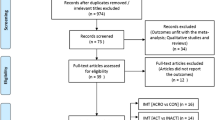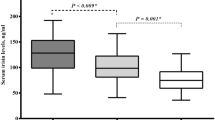Abstract
Purpose
Data regarding atherosclerosis in acromegaly is controversial in literature. We aimed to investigate the markers of early atherosclerosis, oxidative stress, inflammation and their relationships with each other in acromegaly.
Methods
Thirty-nine patients with acromegaly and 40 control subjects were enrolled. Patients were classified into two groups; active acromegaly (AA) and controlled acromegaly (CA). Controls were matched by age, gender, body mass index and presence of cardiovascular risk factors. Flow mediated dilatation (FMD), carotid intima media thickness (CIMT), epicardial adipose tissue thickness (EAT) were measured and serum levels of oxidative stress parameters, high mobility group box 1 protein (HMGB1) and high sensitive CRP (hs CRP) were evaluated.
Results
Significantly decreased FMD, increased CIMT and EAT were found in patients with acromegaly compared to controls (p < 0.01, p < 0.05, p < 0.001, respectively). EAT correlated negatively with FMD (r = −0.24, p = 0.038) and positively with CIMT (r = 0.37, p < 0.01). Presence of acromegaly, hypertension and age were found to be the predictors of early atherosclerosis (p < 0.05). Hs CRP was decreased in AA compared to controls (p = 0.01). There were no significant differences for HMGB1 and oxidized LDL (ox-LDL) cholesterol levels and total antioxidant capacity (TAC) between AA, CA and controls (p > 0.05).
Conclusion
Early atherosclerosis measured with FMD, CIMT and EAT may exist in acromegaly. However, decreased hs CRP and unchanged HMGB1, ox-LDL and TAC levels suggest that inflammation and oxidative stress do not seem to contribute to the development of atherosclerosis in these patients.


Similar content being viewed by others
References
Colao A, Merola B, Ferone D, Lombardi G (1997) Acromegaly. J Clin Endocrinol Metab 82:2777–2781
Katznelson L, Atkinson JL, Cook DM, Ezzat SZ, Hamrahian AH, Miller KK (2011) American Association of Clinical Endocrinologists Medical Guidelines for clinical practice for the diagnosis and treatment of acromegaly–2011 update: executive summary. Endocr Pract 17:636–646
Colao A, Ferone D, Marzullo P, Lombardi G (2004) Systemic complications of acromegaly: epidemiology, pathogenesis and management. Endocr Rev 25:102–152
Akutsu H, Kreutzer J, Wasmeier G, Ropers D, Rost C, Mohlig M, Wallaschofski H, Buchfelder M, Schofl C (2010) Acromegaly per se does not increase the risk for coronary artery disease. Eur J Endocrinol 162:879–886
Mosca S, Paolillo S, Colao A, Bossone E, Cittadini A, Iudice FL, Parente A, Conte S, Rengo G, Leosco D, Trimarco B, Filardi PP (2013) Cardiovascular involvement in patients affected by acromegaly: an appraisal. Int J Cardiol 167:1712–1718
Anderson TJ (1999) Assessment and treatment of endothelial dysfunction in humans. J Am Coll Cardiol 34:631–638
Akgul E, Tokgozoglu SL, Erbas T, Kabakci G, Aytemir K, Haznedaroglu I, Oto A, Kes SS (2010) Evaluation of the impact of treatment on endothelial function and cardiac performance in acromegaly. Echocardiography 27:990–996
Chanson P, Megnien JL, del Pino M, Coirault C, Merli I, Houdouin L, Harris AG, Levenson J, Lecarpentier Y, Simon A, Chemla D (1998) Decreased regional blood flow in patients with acromegaly. Clin Endocrinol (Oxf) 49:725–731
Baykan M, Erem C, Gedikli O, Hacihasanoglu A, Erdogan T, Kocak M, Kaplan S, Korkmaz L, Celik S (2009) Impairment in flow-mediated vasodilatation of the brachial artery in acromegaly. Medical principles and practice : international journal of the Kuwait University. Health Sci Cent 18:228–232
Kartal I, Oflaz H, Pamukcu B, Meric M, Aral F, Ozbey N, Alagol F (2010) Investigation of early atherosclerotic changes in acromegalic patients. Int J Clin Pract 64:39–44
Brevetti G, Marzullo P, Silvestro A, Pivonello R, Oliva G, di Somma C, Lombardi G, Colao A (2002) Early vascular alterations in acromegaly. J Clin Endocrinol Metab 87:3174–3179
Iacobellis G, Corradi D, Sharma AM (2005) Epicardial adipose tissue: anatomic, biomolecular and clinical relationships with the heart. Nat Clin Pract Cardiovasc Med 2:536–543
Xu Y, Cheng X, Hong K, Huang C, Wan L (2012) How to interpret epicardial adipose tissue as a cause of coronary artery disease: a meta-analysis. Coron Artery Dis 23:227–233
Topaloglu O, Sayki Arslan M, Turak O, Ginis Z, Sahin M, Cebeci M, Ucan B, Cakir E, Karbek B, Ozbek M, Cakal E, Delibasi T (2014) Three noninvasive methods in the evaluation of subclinical cardiovascular disease in patients with acromegaly: epicardial fat thickness, aortic stiffness and serum cell adhesion molecules. Clin Endocrinol (Oxf) 80:726–734
Kondo T, Hirose M, Kageyama K (2009) Roles of oxidative stress and redox regulation in atherosclerosis. J Atheroscler Thromb 16:532–538
Nishizawa H, Handayaningsih AE, Iguchi G, Cho Y, Takahashi M, Yamamoto M, Suda K, Kasahara K, Hakuno F, Yamanouchi K, Nishihara M, Seino S, Takahashi S (2012) Enhanced oxidative stress in GH-transgenic rat and acromegaly in humans. Growth Horm IGF Res 22:64–68
Verhelst J, Velkeniers B, Maiter D, Haentjens P, T’Sjoen G, Rietzschel E, Corvilain B, Abrams P, Nobels F, Abs R, Bex M (2013) Active acromegaly is associated with decreased hs-CRP and NT-proBNP serum levels: insights from the Belgian registry of acromegaly. Eur J Endocrinol 168:177–184
Boero L, Manavela M, Gomez Rosso L, Insua C, Berardi V, Fornari MC, Brites F (2009) Alterations in biomarkers of cardiovascular disease (CVD) in active acromegaly. Clin Endocrinol (Oxf) 70:88–95
Tang D, Kang R, Zeh HJ 3rd, Lotze MT (2011) High-mobility group box 1, oxidative stress, and disease. Antioxid Redox Signal 14:1315–1335
Inoue K, Kawahara K, Biswas KK, Ando K, Mitsudo K, Nobuyoshi M, Maruyama I (2007) HMGB1 expression by activated vascular smooth muscle cells in advanced human atherosclerosis plaques. Cardiovasc Pathol 16:136–143
Zhang Z, Wu Y, Zhao Y, Xiao X, Liu J, Zhou X (2013) Dynamic changes in HMGB1 levels correlate with inflammatory responses during cardiopulmonary bypass. Exp Ther Med 5:1523–1527
Giustina A, Chanson P, Bronstein MD, Klibanski A, Lamberts S, Casanueva FF, Trainer P, Ghigo E, Ho K, Melmed S (2010) A consensus on criteria for cure of acromegaly. J Clin Endocrinol Metab 95:3141–3148
Friedewald WT, Levy RI, Fredrickson DS (1972) Estimation of the concentration of low-density lipoprotein cholesterol in plasma, without use of the preparative ultracentrifuge. Clin Chem 18:499–502
Corretti MC, Anderson TJ, Benjamin EJ, Celermajer D, Charbonneau F, Creager MA, Deanfield J, Drexler H, Gerhard-Herman M, Herrington D, Vallance P, Vita J, Vogel R (2002) Guidelines for the ultrasound assessment of endothelial-dependent flow-mediated vasodilation of the brachial artery: a report of the International Brachial Artery Reactivity Task Force. J Am Coll Cardiol 39:257–265
Stein JH, Korcarz CE, Hurst RT, Lonn E, Kendall CB, Mohler ER, Najjar SS, Rembold CM, Post WS (2008) Use of carotid ultrasound to identify subclinical vascular disease and evaluate cardiovascular disease risk: a consensus statement from the American Society of Echocardiography Carotid Intima-Media Thickness Task Force. Endorsed by the Society for Vascular Medicine. J Am Soc Echocardiogr 21:93–111
Lang RM, Badano LP, Tsang W, Adams DH, Agricola E, Buck T, Faletra FF, Franke A, Hung J, de Isla LP, Kamp O, Kasprzak JD, Lancellotti P, Marwick TH, McCulloch ML, Monaghan MJ, Nihoyannopoulos P, Pandian NG, Pellikka PA, Pepi M, Roberson DA, Shernan SK, Shirali GS, Sugeng L, Ten Cate FJ, Vannan MA, Zamorano JL, Zoghbi WA (2012) EAE/ASE recommendations for image acquisition and display using three-dimensional echocardiography. Eur Heart J Cardiovasc Imaging 13:1–46
Iacobellis G, Assael F, Ribaudo MC, Zappaterreno A, Alessi G, Di Mario U, Leonetti F (2003) Epicardial fat from echocardiography: a new method for visceral adipose tissue prediction. Obes Res 11:304–310
Reyes-Vidal C, Fernandez JC, Bruce JN, Crisman C, Conwell IM, Kostadinov J, Geer EB, Post KD, Freda PU (2014) Prospective study of surgical treatment of acromegaly: effects on ghrelin, weight, adiposity, and markers of CV risk. J Clin Endocrinol Metab 99:4124–4132
Sakai H, Tsuchiya K, Nakayama C, Iwashima F, Izumiyama H, Doi M, Yoshimoto T, Tsujino M, Yamada S, Hirata Y (2008) Improvement of endothelial dysfunction in acromegaly after transsphenoidal surgery. Endocr J 55:853–859
De Martino MC, Auriemma RS, Brevetti G, Vitale G, Schiano V, Galdiero M, Grasso L, Lombardi G, Colao A, Pivonello R (2010) The treatment with growth hormone receptor antagonist in acromegaly: effect on vascular structure and function in patients resistant to somatostatin analogues. J Endocrinol Invest 33:663–670
Li G, Del Rincon JP, Jahn LA, Wu Y, Gaylinn B, Thorner MO, Liu Z (2008) Growth hormone exerts acute vascular effects independent of systemic or muscle insulin-like growth factor I. J Clin Endocrinol Metab 93:1379–1385
Iacobellis G, Malavazos AE, Corsi MM (2011) Epicardial fat: from the biomolecular aspects to the clinical practice. Int J Biochem Cell Biol 43:1651–1654
Whayne TF Jr (2013) Epicardial fat thickness in heart failure and other clinical conditions. Angiology 64:169–172
Sacks HS, Fain JN (2007) Human epicardial adipose tissue: a review. Am Heart J 153:907–917
Mazurek T, Zhang L, Zalewski A, Mannion JD, Diehl JT, Arafat H, Sarov-Blat L, O’Brien S, Keiper EA, Johnson AG, Martin J, Goldstein BJ, Shi Y (2003) Human epicardial adipose tissue is a source of inflammatory mediators. Circulation 108:2460–2466
Bogazzi F, Battolla L, Spinelli C, Rossi G, Gavioli S, Di Bello V, Cosci C, Sardella C, Volterrani D, Talini E, Pepe P, Falaschi F, Mariani G, Martino E (2007) Risk factors for development of coronary heart disease in patients with acromegaly: a five-year prospective study. J Clin Endocrinol Metab 92:4271–4277
Otsuki M, Kasayama S, Yamamoto H, Saito H, Sumitani S, Kouhara H, Saitoh Y, Ohnishi T, Arita N (2001) Characterization of premature atherosclerosis of carotid arteries in acromegalic patients. Clin Endocrinol (Oxf) 54:791–796
Higashi Y, Sukhanov S, Anwar A, Shai SY, Delafontaine P (2010) IGF-1, oxidative stress and atheroprotection. Trends Endocrinol Metab 21:245–254
von der Thusen JH, Borensztajn KS, Moimas S, van Heiningen S, Teeling P, van Berkel TJ, Biessen EA (2011) IGF-1 has plaque-stabilizing effects in atherosclerosis by altering vascular smooth muscle cell phenotype. Am J Pathol 178:924–934
Steinberg D, Witztum JL (2002) Is the oxidative modification hypothesis relevant to human atherosclerosis? Do the antioxidant trials conducted to date refute the hypothesis? Circulation 105:2107–2111
Anagnostis P, Efstathiadou ZA, Gougoura S, Polyzos SA, Karathanasi E, Dritsa P, Kita M, Koukoulis GN (2013) Oxidative stress and reduced antioxidative status, along with endothelial dysfunction in acromegaly. Horm Metab Res 45:314–318
Yousuf O, Mohanty BD, Martin SS, Joshi PH, Blaha MJ, Nasir K, Blumenthal RS, Budoff MJ (2013) High-sensitivity C-reactive protein and cardiovascular disease: a resolute belief or an elusive link? J Am Coll Cardiol 62:397–408
Vilar L, Naves LA, Costa SS, Abdalla LF, Coelho CE, Casulari LA (2007) Increase of classic and nonclassic cardiovascular risk factors in patients with acromegaly. Endocr Pract 13:363–372
Andreassen M, Vestergaard H, Kristensen LO (2007) Concentrations of the acute phase reactants high-sensitive C-reactive protein and YKL-40 and of interleukin-6 before and after treatment in patients with acromegaly and growth hormone deficiency. Clin Endocrinol (Oxf) 67:909–916
Lin E, Wexler TL, Nachtigall L, Tritos N, Swearingen B, Hemphill L, Loeffler J, Biller BM, Klibanski A, Miller KK (2012) Effects of growth hormone deficiency on body composition and biomarkers of cardiovascular risk after definitive therapy for acromegaly. Clin Endocrinol (Oxf) 77:430–438
Arikan S, Bahceci M, Tuzcu A, Gokalp D (2009) Serum tumour necrosis factor-alpha and interleukin-8 levels in acromegalic patients: acromegaly may be associated with moderate inflammation. Clin Endocrinol (Oxf) 70:498–499
Lohr J, Grotevendt A, Nauck M, Volzke H, Wallaschofski H, Friedrich N (2014) Relation of insulin-like growth factor-I and IGF binding protein 3 with markers of inflammation: results of a population-based study. Clin Endocrinol (Oxf) 80:148–154
Acknowledgments
We gratefully acknowledge Sevilay Karahan for her help in statistical analysis.
Conflict of interest
The authors declare that they have no conflict of interest.
Author information
Authors and Affiliations
Corresponding author
Rights and permissions
About this article
Cite this article
Ozkan, C., Altinova, A.E., Cerit, E.T. et al. Markers of early atherosclerosis, oxidative stress and inflammation in patients with acromegaly. Pituitary 18, 621–629 (2015). https://doi.org/10.1007/s11102-014-0621-6
Published:
Issue Date:
DOI: https://doi.org/10.1007/s11102-014-0621-6




